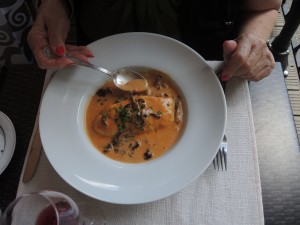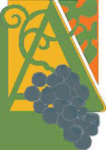lummi island wine tasting June 28 ‘014
Jura Wines: Ouillé vs. Sous Voile
 One of the greatest highlights of our trip was our visit to the Jura wine region of France, north of Geneva and east of Burgundy. Here there is a very long history of making oxidized wines, which taste very, very different from the wines we are all used to. We spent three days in the absolutely charming town of Arbois, exploring the food and wine of this unique and beautiful area.
One of the greatest highlights of our trip was our visit to the Jura wine region of France, north of Geneva and east of Burgundy. Here there is a very long history of making oxidized wines, which taste very, very different from the wines we are all used to. We spent three days in the absolutely charming town of Arbois, exploring the food and wine of this unique and beautiful area.
The simplest way to explain Jura wines is to point out that however wine is aged, there is always some evaporation, often called the “angel’s share.” The most common practice of winemakers around the world is to top off barrels frequently in order to keep air away from the wine in order to prevent oxidation. In Jura, however, the traditional method is to let the wine evaporate without topping up, which causes two things to happen. First, the wine oxidizes as wine evaporates and the wine is exposed to more and more air. Second, the local air contains naturally occurring yeasts which start growing on the surface of the wine. As in the photo at left, the wines develop a veil (voile) of yeast on the surface where the air touches the wine. As the yeast dies, it sinks to the bottom, even while new yeast grows on the surface.
The entire process is very similar to how sherry is made in Jerez, Spain, and wines from Jura do taste a bit like fino sherry. In the photo at left of Desiree Petit winemaker Damien during their big annual release event over their annual Ascension Thursday (I am not making this up) weekend, you can see the inner workings of the sous voile (under the veil) aging process, in contrast to the more common ouillé process of topping up barrels to prevent oxidation. Sometime in the next few months we will pour both styles of Jura’s most famous grape, savagnin, in both styles, so you can taste the difference!
Lyon: it’s the Food, Dude!
 Lyon is France’s second largest city. And though Paris is absolutely a World Capital in every respect, even Parisians give a nod to Lyon as the Food Capital of France. This reputation dates back to the early nineteenth century shortly after the French Revolution, when “Les Mères Lyonnaises” began a tradition of “honest cooking with taste and spirit, but most of all―with local and seasonal top quality ingredients.” Thus Lyon designed the day’s menu around what was available that day in the market. The tradition of Les Meres led to the contemporary Bouchon which one finds thoughout the more touristy areas of Lyon, and which offer traditional Lyonnaise dishes.
Lyon is France’s second largest city. And though Paris is absolutely a World Capital in every respect, even Parisians give a nod to Lyon as the Food Capital of France. This reputation dates back to the early nineteenth century shortly after the French Revolution, when “Les Mères Lyonnaises” began a tradition of “honest cooking with taste and spirit, but most of all―with local and seasonal top quality ingredients.” Thus Lyon designed the day’s menu around what was available that day in the market. The tradition of Les Meres led to the contemporary Bouchon which one finds thoughout the more touristy areas of Lyon, and which offer traditional Lyonnaise dishes.
For the Real Thing we actually booked a lunch at the most famous reincarnation of Les Mères Lyonnaises, La Mere Brazier (Michelin **), with our seasonal neighbor Brenda. All you need to know is that there was a platoon of black-suited wait-staff attending to our every need. We Knew we were in a thinner atmosphere when, as we got off the city bus right in front of the restaurant (in a bit of rain) the liveried Doorman came to Brenda’s rescue with an umbrella and an arm, to guide her all the way to the door, and the subsequent meal was a parade of exquisitely prepared and beautiful dishes.
What show is that???
Southern France is littered with well-preserved Roman ruins, such as the Pont du Gard and the amphitheater at Nimes, both of which date back some two thousand years– a very long time to us, a passing moment to our Planet. So it is that we took the Funicular (tram) up the hill from Vieux Lyon to the plateau overlooking the city, with its spectacular panorama, and took a leisurely stroll to the ruins of the old Roman amphitheatre dating back the the 1st Century. We were drawn to it because Amplifiers were filling the Air with Sound. On arrival, we found a rehearsal in progress of a fascinating show, obviously American, with great music. We have not been able to sort out what show it is, or whether it will play at the Amphitheatre or not. All I can say is that we would buy tickets Immediately if we knew how, where, and when!
This week’s Tasting Notes
Perazzeta Sara Bianco ’13 Italy $11
Something of a “super-tuscan white,” this blend of Trebbiano, Malvasia, Chardonnay, and Sauvignon Blanc has arrived just in time for Summer. Nose of lemon zest, sage, mango, and pineapple leads to a rich bouquet of flavor and a crisp, refreshing finish.
Chateau Lancyre Rose ’12 France $15
(50% syrah, 40% grenache, 10% cinsault): Bright pink. Intense red berry and tangerine with notes of anise and white flowers; juicy and precise, with palate-coating cranberry and bitter cherry flavors.
Crios de Susana Balbo Malbec ’11 Argentina 89pts $14
Crushed blackberry, licorice and violet on the lively nose. Quite ripe and sweet in the mouth, showing impressive volume and breadth for the price range. Finishes with serious ripe tannins and noteworthy persistence.
Tineta Ribera del Duero ’11 Spain 91 pts $12
100% tempranillo; copious notes of creme de cassis intermixed with hints of wood smoke and charcoal. Intense aromas of blueberry, cherry liqueur, licorice and Indian spices. Lively, sweet and spicy in the mouth, with energetic black and blue fruit flavors, zesty minerality, and notes of bitter chocolate and dark berries on a long, spicy and sharply focused finish.
Avignonesi Rosso de Montepulciano ’11 Italy $18
Perfumed aromas of red berries, violets, cinnamon, and almond flower. Juicy and bright, with precise strawberry and redcurrant flavors and lively acidity. Finishes long and fresh, with lingering floral perfume.
If you enjoyed this post, please consider to leave a comment or subscribe to the feed and get future articles delivered to your feed reader.

 2072 Granger Way
2072 Granger Way